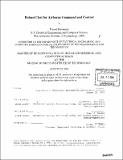| dc.contributor.advisor | Clifford J. Weinstein and Roger I. Khazan. | en_US |
| dc.contributor.author | Ramanan, Prasad, 1980- | en_US |
| dc.contributor.other | Massachusetts Institute of Technology. Dept. of Electrical Engineering and Computer Science. | en_US |
| dc.date.accessioned | 2005-06-02T19:41:24Z | |
| dc.date.available | 2005-06-02T19:41:24Z | |
| dc.date.issued | 2003 | en_US |
| dc.identifier.uri | http://hdl.handle.net/1721.1/18028 | |
| dc.description | Thesis (M. Eng.)--Massachusetts Institute of Technology, Dept. of Electrical Engineering and Computer Science, September 2003. | en_US |
| dc.description | "August 22, 2003." | en_US |
| dc.description | Includes bibliographical references (p. 87-88). | en_US |
| dc.description.abstract | We present the design, implementation, and evaluation of a prototype robust textual chat application to be utilized in dynamic distributed environments such as the Multi-Sensor Command and Control Constellation (MC2C). The MC2C environment consists of a set of airborne and ground sites, each of which contains a cluster of clients. Intra-site communication is reliable and exhibits high performance, whereas the performance and reliability of inter-site communication is variable and unpredictable. The two primary goals of the chat application are to deliver messages to clients with low latency and a globally consistent ordering. Since these goals conflict, our protocols strike a balance by satisfying a new property that we call the Intermittent Global Order (IGO) property. A protocol satisfying the IGO property guarantees global order while network connectivity permits, and sacrifices global order for bounded message delivery latencies while maintaining an intuitive and well-defined ordering on the message delivery when critical network connections are lost. We implemented our protocols on a hierarchical system architecture that places a server at every MC2C site. We developed a test-bed that simulates four MC2C sites in order to test the prototype. Testing revealed that the various IGO protocols implemented in the prototype all achieve the goals of robust and efficient collaborative communication even in the face of frequent link outages, but differ in how each balances global order and latency. | en_US |
| dc.description.statementofresponsibility | by Prasad Ramanan. | en_US |
| dc.format.extent | 88 p. | en_US |
| dc.format.extent | 5268337 bytes | |
| dc.format.extent | 5278075 bytes | |
| dc.format.mimetype | application/pdf | |
| dc.format.mimetype | application/pdf | |
| dc.language.iso | eng | en_US |
| dc.publisher | Massachusetts Institute of Technology | en_US |
| dc.rights | M.I.T. theses are protected by copyright. They may be viewed from this source for any purpose, but reproduction or distribution in any format is prohibited without written permission. See provided URL for inquiries about permission. | en_US |
| dc.rights.uri | http://dspace.mit.edu/handle/1721.1/7582 | |
| dc.subject | Electrical Engineering and Computer Science. | en_US |
| dc.title | Robust chat for airborne command and control | en_US |
| dc.type | Thesis | en_US |
| dc.description.degree | M.Eng. | en_US |
| dc.contributor.department | Massachusetts Institute of Technology. Department of Electrical Engineering and Computer Science | |
| dc.identifier.oclc | 57240474 | en_US |
